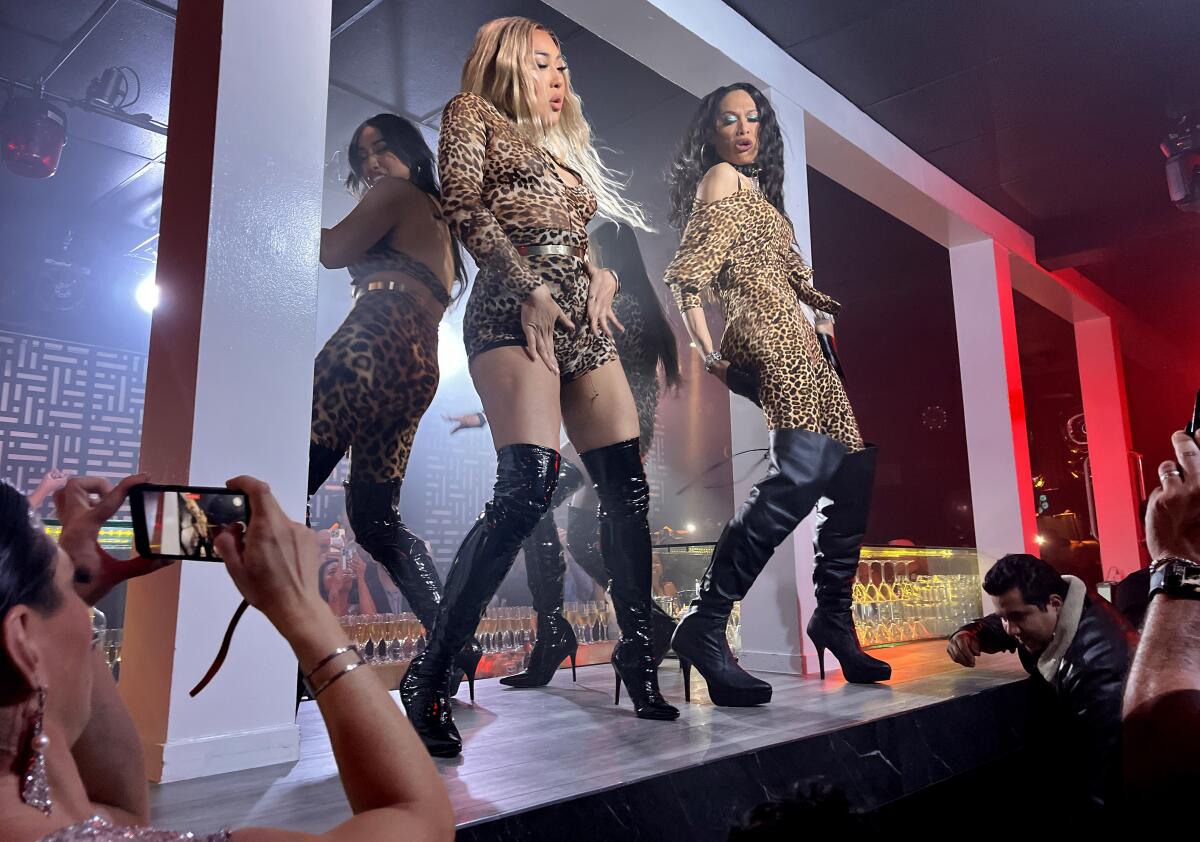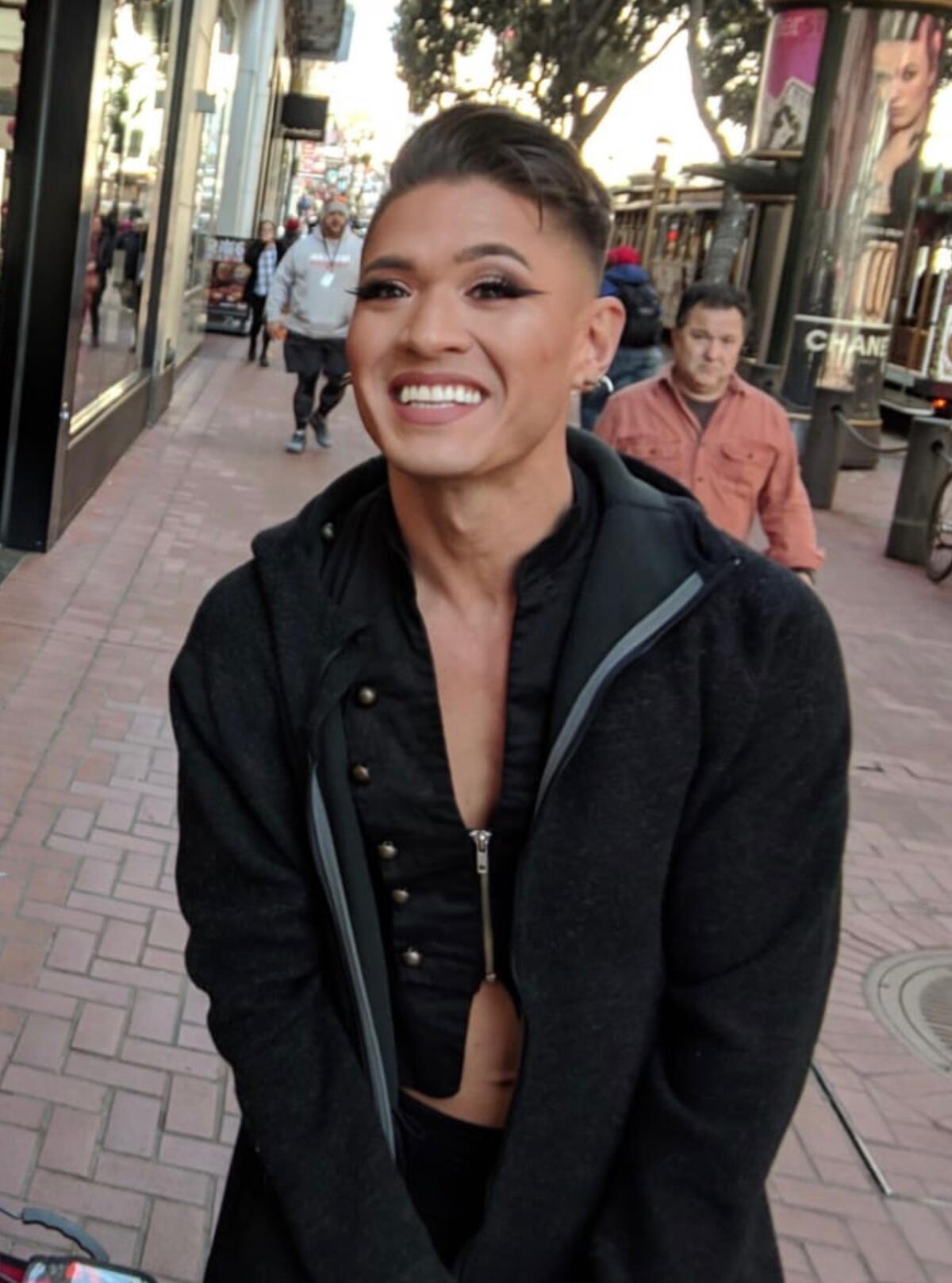Column: Sorry, San Francisco is not the crime-ridden hellhole the far right claims it is

SAN FRANCISCO — The first time Kenshi Westover walked into AsiaSF, an iconic transgender cabaret in this city’s gritty South of Market neighborhood, it was as a closeted gay Mormon visiting from Utah.
That was 20 years ago, and Westover (who uses they/them pronouns) remembers being stunned by the performers strutting down an elevated runway behind the bar, heels impossibly high, dresses dangerously low cut, the mood ebullient.
“These are my spirit animals,” Westover thought. “And I am going to be part of that world.”

I met Westover on Sunday night as AsiaSF celebrated its 25-year anniversary, in a room packed sardine-tight with drag queens, politicos in suits and even a couple of Stanford students. Westover, who identifies as gender nonconforming, was turned out in a beaded Art Deco gown, with dangling earrings and slicked-back hair, very much a part of this vibrant community that reveals more about San Francisco than the alarmist tales of urban doom that have come to define its reputation nationwide.
For years, the hard-right outrage machine has zeroed in on San Francisco as a “hellhole” that epitomizes everything wrong with Democratic leadership. They have been aided by a small but vocal cadre of local social media influencers who have made their brand pummeling San Francisco’s public health and public safety policies. They focus almost entirely on drugs and crime, which dovetails perfectly into the right-wing propaganda that’s stoking paranoia and panic in various parts of the country.
If you’re wondering why I’m not including the usually obligatory sample posts from these influencers, it’s because I don’t feel the need to give that false narrative more oxygen. But their new king seems to be Elon Musk, who recently tweeted out that “violent crime in SF is horrific,” despite the reality that, with the exception of robberies, rates for violent crimes like homicide and rape are so far on par or declining from last year.
Many of these proselytizers protest that they are not conservative, and most wouldn’t dare to touch other issues that animate the right, such as the wars on transgender people and abortion. But they have a symbiotic relationship with hard-right media (think Fox News) on crime and drugs.
In another California town, maybe Sacramento or even Los Angeles, their vitriol would be the stuff of Nextdoor posts. But because San Francisco is a target of the right wing, these local voices have amassed power by providing the so-called proof that this city, like other Democratic strongholds, is in perpetual chaos.
They post countless videos online of what I consider exploitative moral-outrage porn — clips of destitute people using drugs, splayed out on sidewalks, incoherent and lost. Few of these appear to be filmed with the person’s consent, but all are meant to convey to the good folks in Iowa and Idaho just how bad life can be under “leftist” leadership.
Of course, that narrative is not new.
In 2015, then-presidential candidate Donald Trump called out San Francisco and its sanctuary city policies after the horrific killing of resident Kathryn Steinle, who was shot by an undocumented immigrant with an extensive criminal record and a history of deportations. The shooter, Jose Ines Garcia Zarate, was acquitted of murder after a jury decided he had found the gun under a bench and accidentally fired it. The weapon belonged to a Bureau of Land Management ranger and had been stolen from his vehicle a week earlier.
But with the success of Trump’s political attack on the hearts and minds of immigrant-averse Republicans, the pile-on of exploiting woe has continued, culminating recently in the aftermath of the killing of tech entrepreneur Bob Lee.
Lee was stabbed in the early-morning hours of April 4 in an upscale area of downtown. By the next morning, right-wing social media were drowning in condemnations of the city that assumed Lee had been randomly attacked — the unspoken implication that the assailant was likely a homeless drug user. Lee’s death quickly became just the latest proof of how violent San Francisco has become despite its continuing low homicide rate.
Police eventually arrested an acquaintance of Lee’s for the killing, suggesting the attack may have been motivated by a dispute involving the suspect’s sister. Not a random killing at all, but that hasn’t stopped these vendors of grievance. After the arrest, one frequent social media poster suggested that it didn’t matter who did it, because any type of killing proves just how dangerous San Francisco is.
On Friday, when Gov. Gavin Newsom announced a multiagency effort, including the California National Guard, to target large drug distributors in San Francisco, another one of those agitators declared “victory,” wrongly claiming that soldiers would be on the streets because the situation was so dire. CalGuard will provide backroom intelligence-gathering aid. There will be no tanks.
San Francisco has problems, of course. Not little ones. There’s a tech bust emptying expensive office towers, much like the dot-com bubble did around the same time AsiaSF first opened.
There is also a crisis of addiction, which has led to unacceptable levels of property crime as well as areas of the city where drugs are openly sold and used, and stolen goods hawked at sidewalk markets. As with so many other places — urban, suburban and rural — fentanyl has become the drug of choice, leading to skyrocketing numbers of overdoses. So far this year, 200 people have died of fentanyl overdoses in the city compared with 142 deaths in the same period last year.
And anti-Asian hate crimes, largely unrelated to the addiction crisis, have rightfully galvanized anger — having increased 167% nationwide between 2020 and 2021, according to FBI data, far outpacing rises for any other group. In San Francisco that has included, among other brazen attacks, an Asian man dying after being shoved into the street, a man throwing a brick at elderly Asian people in a park, and an elderly woman being robbed and beaten by four juveniles in her senior living center.
Anti-Asian hate crimes seem to be declining this year, but Asian communities have become more vocal and political in their demands to better police the city — appeals that at times have been conflated with the far-right talking points but which stem from very different perspectives.
A recent city survey found all residents, regardless of ethnicity, feel less safe than before the pandemic.
Only 36% of respondents said they felt safe or very safe walking alone in their neighborhood at night. In 2019, 53% said they felt safe at night.
Despite that decline, the overall grade for residents’ feelings about safety came in at a C+, which isn’t great but isn’t a hellhole failure, either.
Which is to say, don’t believe the hype you read about San Francisco on the internet.
“The real San Francisco is AsiaSF. It’s the cherry blossom parade. It’s Easter with the Sisters of Perpetual Indulgence in Dolores Park,” state Sen. Scott Wiener told me, when we stepped outside the club to talk. For those who don’t know, the sisters are a collective of activist queer and transgender nuns who have been around since Jimmy Carter was in the Oval Office. They like to roller skate.
“This is a place with a soul that can’t be stifled,” said Bette McKenzie, a former public relations executive who helped conceive one of the largest AIDS fundraisers on the West Coast, as we screamed over the pounding beat back inside the club.
“In spite of all the BS you hear from the right-wing media, San Francisco is a beacon of hope for so many people,” Larry Hashbarger told me. He’s one of the owners of AsiaSF.
He came to San Francisco from Boulder, Colo., in 1977, a “young gay man who was not quite ready for the scene.” At 71, he is the scene, working the room in a black bedazzled suit fashioned after a Keith Haring painting.
When AsiaSF opened, “the word transgender was not even in our vocabulary yet,” Hashbarger told me.
But still, everyone wanted to come. “Pacific Heights matrons would bring their Dom Perignon.”
Since then, he estimates a million people have come through the doors. On Friday, Mayor London Breed stopped by, he said. Former U.S. House Speaker Nancy Pelosi, a San Francisco resident, sent a proclamation “in recognition of outstanding and invaluable service to the community.” Even state Treasurer Fiona Ma was there with her brother on Sunday.
“Everybody comes to be who they are and celebrate who they are. No matter who you are, you have to find your truth and live your truth,” Hashbarger said.
And that is the enduring strength of San Francisco. People go to New York and Los Angeles seeking fame and wealth. People come to San Francisco seeking themselves — searching for freedom and authenticity.
Those who find their own identity and their own tribes are the true powers in this city, building communities with clout and endurance. Just look at who gets elected, from Harvey Milk, the first openly gay man to hold office in California, to Wiener, who has championed a progressive agenda that has made him reviled by the right.
For a small minority, their truth is always going to be born of spite and privilege. And that minority will have its power, as democracy demands, especially in this perverse American timeline in which the push toward authoritarianism requires hate and fear to justify itself. That, said Wiener, is a “challenge,” but one San Francisco always has and always will overcome.
For the majority of San Francisco, the outrage peddlers are a sideshow, a pale whisper against the force of the real show in places like AsiaSF.
Decades ago, Westover, the closeted Mormon, found themselves standing on a 20-foot ladder, contemplating suicide — jumping to see if that could quiet the noise and the pain. They were 23. Their parents had rejected them, and being gay or transgender or something else entirely seemed terrifying. Seeing the performers of AsiaSF gave Westover the courage to define themselves on their own terms.
On Sunday night, I saw Westover as a beautiful human wholly owning who they are, surrounded by found family.
“This city is a safe sandbox that allows a person to play without fear,” Westover told me. “I think it saved my life.”
They aren’t the only one San Francisco has saved, and they won’t be the last.
That’s the beauty of this city, and no amount of fear-mongering will change it.
More to Read
Sign up for Essential California
The most important California stories and recommendations in your inbox every morning.
You may occasionally receive promotional content from the Los Angeles Times.











